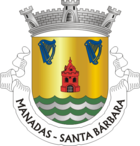Manadas
| Manadas (Santa Bárbara) | ||||||
|---|---|---|---|---|---|---|
|
||||||
| Basic data | ||||||
| Autonomous Region : | Azores | |||||
| Concelho : | Velas | |||||
| Coordinates : | 38 ° 38 ′ N , 28 ° 6 ′ W | |||||
| Residents: | 374 (as of June 30, 2011) | |||||
| Surface: | 11.2 km² (as of January 1, 2010) | |||||
| Population density : | 33 inhabitants per km² | |||||
| Postal code : | 9800-026 | |||||
| politics | ||||||
| Mayor : | Vasco Fernandes Matos ( PS ) | |||||
| Address of the municipal administration: | Junta de Freguesia de Manadas (Santa Bárbara) Rua St. Bárbara 6 9800-026 Manadas (Santa Bárbara) |
|||||
Manadas (Santa Bárbara) is a Portuguese municipality ( freguesia ) in the district ( concelho ) of Velas , in the Azores . It has 374 residents (as of June 30, 2011).
history
After the district town of Velas was founded in 1460, the settlement of the island of São Jorge began. In 1510 the first church was built in Manadas. Manadas has been an independent parish since 1559 and is one of the first six parishes.
administration
Manadas is the seat of a municipality of the same name ( Freguesia ). The following localities are in the municipality:
- Fajã das Almas
- Manadas
- Terreiros
architecture
Manadas is known for its Igreja de Santa Bárbara church , the oldest part of which was built towards the end of the 15th century, and which is considered to be one of the most beautiful churches in the Azores. In the vicinity of the church there is a bastion as well as well-preserved remains of the wall with loopholes of the Forte das Manadas fortress , which was created in 1689 through the conversion of a viewpoint for whale watching that was built here in 1647. The fortress was partially demolished in 1931 and the stones were reused in 1932 to build a school. At the entrance to the fortress , the history of the fortress is explained on a plaque consisting of 40 azulejos typical of Portugal and designed in 1902.
Behind the church is the hamlet of Manadas with several older houses made of lava stone and a small Holy Spirit chapel ( Império das Manadas ), which was built in 1935. Its gable is adorned with a colored relief depicting a crown and a dove, the symbol of the Holy Spirit. In contrast to most of the other chapels of the Holy Spirit in the Azores, there is a cross and not a crown on the pediment. Manadas has a small fishing port, next to which a swimming area has been created.
vegetation
Several dragon trees grow in and around Manadas , from whose bark a reddish sap was previously obtained by scratching, which was used to dye textiles. The physic nut can also be found in and around Manadas. Their fruits were used to produce an oil that is suitable for lubricating machines and used to be an important commodity.
Web links
- Manadas website (Portuguese)
- German-language website for Manadas in the Azores portal www.azoren-online.com
Individual evidence
- ↑ a b www.ine.pt - indicator resident population by place of residence and sex; Decennial in the database of the Instituto Nacional de Estatística
- ↑ Overview of code assignments from Freguesias on epp.eurostat.ec.europa.eu
- ↑ www.azoren-online.com , accessed on August 23, 2013
- ↑ Stéphan Szeremeta: Açores , p. 246. Paris 2014
- ↑ http://www.azoren-online.com/saojorge/tipps/sehenswuerdheiten/manadas/index.shtml





